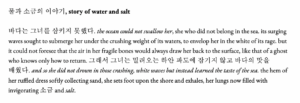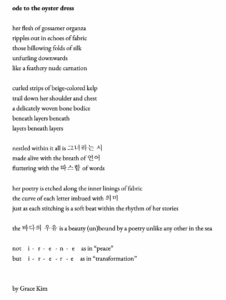The Oyster Dress Reimagined to be a Cyborg
By Grace Kim


Quote from Theoretical Text
“The poetry and stories of U.S. women of color are repeatedly about writing, about access to the power to signify… Cyborg writing is about the power to survive, not on the basis of original innocence, but on the basis of seizing the tools to mark the world that marked them as other” (Haraway 33).
Catalog Essay
Every fiber of Alexander McQueen’s Oyster Dress is crafted to tell a story that shudders with life in the way it speaks of a beauty who emerges from the devastation of a shipwreck, not broken as a result of her fragility but transformed and revived into an enduring survivor. The Met’s online catalog describes this piece from McQueen’s 2003 spring/summer collection in the following manner: “But unlike Aphrodite, who was born in the foam of the sea and borne to shore on a scallop, McQueen’s beauty is a bruised pearl encased in a deconstructing oyster, the tumbled survivor of the violent action of waves” (“Oyster Dress”). There is an interesting dichotomy here, one between a divine being and “a bruised pearl,” between a natural birth of seafoam and an unnatural emergence “in a deconstructing oyster,” between a gracefully awaited arrival to shore and an unexpected surfacing of a tattered, “tumbled survivor.” Indeed, something about the Oyster Dress is not as it should be. Its dirty appearance, asymmetrical design, and sufferance of oceanic trauma—all of which should speak of anything but beauty—make it, for some reason, just as aesthetically striking as a pure and perfect goddess who knows only of quiet waters that ebb and flow at her will. Perhaps it is the aspect of narrative within the Oyster Dress that makes it so compelling, its message of resilience more within the reach of a human audience who cannot help but desire to be empowered by this tale of survival.
It is this very tale that Barbara Haraway, too, is heavily invested in when she writes of yet another inhuman being who narrates its own version of survival: the cyborg. Haraway’s cyborg is anything but innocent, natural, and desired; its very existence defies the enforcement of strict social boundaries established by tradition and patriarchy, instead synthesizing different elements within each boundary to then fashion together a new, rebellious identity that is the cyborg. Taking this notion of social boundaries to encompass that of race and gender, Haraway argues that “women of color might be understood as a cyborg identity, a potent subjectivity synthesized from a fusion of outsider identities” (Haraway 32). Like McQueen’s Oyster Dress, Haraway’s cyborgian “women of color” also goes against what is perceived to be natural in its narrative emphasis upon survival, ultimately surviving by creating its own space within a world that deems it to be unfitting of belonging in any of its erected social boundaries.
Putting Haraway in conversation with McQueen reveals that we can not only draw a parallel between the cyborg and the Oyster Dress but also see how the cyborg can extend the narrative of the Oyster Dress. The girl from the shipwreck does not have to be just any girl identified only by her femininity—she can become a woman of color who survives the shipwreck of sexist and racial prejudices upon sailing in a bounded sea, a figure whose identity is a merge of gender and race so that her story of survival becomes all the more socially compelling. My poetic alteration of the Oyster Dress, then, is an imagination of this extension. Indeed, the Oyster Dress is made into a cyborg through poetry, its narrative of survival retold and reimagined through the hybrid language of a woman of color. This reimagined narrative is then made beautiful in the way it intends to empower Asian American women, elevating the intricacy of their identities over the threats of intersectionality.
My alteration begins with a photograph, one that I personally took during our class trip to The Met’s Costume Institute. One of the curators noticed my visibly apparent fascination with the Oyster Dress—its presence so full and commanding of attention that it almost looked like a body laying there on the table—and offered to lift up the skirt so that I could examine its interior, gingerly touching the silk with a gloved hand so as not to disturb the fabric in its incredible fragility. I was immediately struck by the detail of the dress’s interior: the external ruffles, rippled to imitate the texture of an oyster shell, were a result of countless layers that were stitched together, line upon line upon line showing evidence of these intricate stitchings. I initially took a photo to capture the fine detail of its interior and later realized that this particular shot was unique in that not many spectators, I imagine, have observed the inside of the dress as they have done the outside. Despite its lack of attention, this interior angle is imperative to understanding the complexity of the Oyster Dress, as it reveals the underlying artistic thought and labor that makes possible its more widely recognized external beauty. Reflecting upon this notion of artistic thought and labor, I came to imagine the inner linings of the skirt’s interior as lines of notebook paper, almost as if the story of the dress was waiting to be written in the same way a poet scribbles down their musings upon a sheet of paper. Indeed, there is something deeply intimate about the way a handwritten piece of art appears on a page, raw and authentic in its humble capturing of one’s thought in one’s voice, translating timbre into handwriting. Seeing as how my reimagined poems would be intensely personal to me, not only in writing in English and Korean but also in my experience as an Asian American woman, I viewed the technology of handwriting as my means of embodying my unique story through this unique photograph.
The first of my two poems—the number two being significant here as, according to the specialists at The Costume Institute, there are only two Oyster Dresses in existence—is a story in the form of a poem, aptly titled “물과 소금의 이야기, story of water and salt” in both Korean and English. The title signals my approach to what Haraway calls a “chimera” of language when she cites Cherrie Moraga’s work (Haraway 33), with my interpretation of this involving a work that is written in both my Korean mother tongue and native English language. Each time, the line in Korean is followed by a translation in English, the translations made distinct from the lines intentionally written in English by either being written in cursive in my handwriting or being italicized in typed font. In telling the story, I draw upon McQueen’s original narrative in his 2003 spring/summer exhibition, in which “the show opened with an underwater film directed by John Maybury that showed a girl in a torn chiffon dress plunge into the sea and appear to drown” (Bethune). Then, applying Haraway’s concept of women of color, I add my own spin: the girl in the poem is Asian American, the ocean becomes a white-dominated space in which she is a racial minority, and the rapid waves become the accumulated force of explicit acts of racism and more discreet signs of microaggressions. The girl survives because she is a cyborg, because she cannot be drowned in a place where she does not already belong. The very aspect of herself that the waves sought to target in their attacks—the air in her bones, the identity within—is what keeps her alive. When she emerges, she has “learned the taste of the sea,” turning the bitterness of salt into something that can no longer harm her but is part of her, making her all the more resilient and enduring in the wake of her transformation. In this way, my first poem uses this personal medium of poetry—my writing a linguistic cyborg in and of itself in its incorporation of both Korean and English—to reimagine the survival of McQueen’s Oyster Dress as the survival of Haraway’s cyborg, aiming to empower this particular woman of color by narrating the importance of her Asian American identity.
My second piece, then, is a poem about poetry. Calling back to Haraway’s idea of how literacy can be a medium of influence, voice, and “recoding communication” for women of color (Haraway 33), I write a celebratory ode to the Oyster Dress, as both McQueen’s original dress and my reimagination of it as poetry. The first two stanzas exemplify my experimentation with the English language, intentionally flowery with the purpose of honing my personal fascination with this language as an aspiring student of English. Such descriptions make homage to my observations of McQueen’s dress, drawing from the notes that I took when I had the opportunity to view it in-person. Lines 9 and 10—criss-crossed to not only mimic the lattice design of the actual bone bodice but also to quite literally place the word “beneath” beneath “layers”—signal a transition, moving away from the flowery English of the poem’s opening to another form of linguistic experimentation. Here, I evolve my chimera of language, no longer following each line of Korean with an English translation but simply keeping the message in Korean so that, when read in its entirety, the poem is fully expressed through Korean just as much as it is expressed in English. (For the purposes of explanation, however, I will include here that, in the order they appear in the poem, “그녀라는 시” means “she who is poetry”; “언어” means “language”; “따스함” means “warmth”; “의미” means “meaning”; and “바다의 우유” means “milk of the sea.”) There is a way the Asian American girl in the first poem uses a language of her own—perhaps even is a language of her own—to speak into the world in which no one else can. Her words are embedded with the truth of her lived stories, saturated with a meaning that only she can know and have. Her literacy, the very thing that makes her distinct as a woman of color and thus marks her as the other that is the cyborg, is precisely what enables her to continually survive after her initial survival. Her literacy is at the core of her identity, so inherent that she cannot be separated from it and, in a sense, embodies it through the physically legible letters that are “etched along the inner linings of fabric.” Thus, the presence of the “(un)bound” signals the simultaneous binding together of her unique language to continually fashion her cyborg identity, as well as her unbinding from traditional boundaries as a result of becoming a cyborg. The final two lines culminate this aspect of becoming, inspired by my own initial mistake in misreading “Irere,” the title of McQueen’s 2003 spring/summer collection, as the more common name “Irene.” Indeed, this process of becoming, of surviving is not one that is as simple as having immediate peace upon emerging from the shipwreck: it is one of continual progress, growth, and change as signaled by such a transformation. This transformation—the very meaning carried by the name “Irere” in “one of the indigenous Amazonian languages” (Bethune)—is what fuels an already intricate identity with even more intricacy, infusing McQueen’s original narrative of survival with a depth that is made possible through Haraway’s cyborg women of color.
Works Cited
Bethune, Kate. Encyclopedia of Collections: Irere, The Museum of Savage Beauty, 2015, https://www.vam.ac.uk/museumofsavagebeauty/rel/encyclopedia-of-collections-irere/.
Haraway, Donna. “‘A Manifesto for Cyborgs.’” Encyclopedia of New Media, 2003, https://doi.org/10.4135/9781412950657.n155.
“‘Oyster Dress.’” Metmuseum.org, The Metropolitan Museum of Art, https://www.metmuseum.org/art/collection/search/88645.
Image Personally Taken by Author at the Costume Institute. Artist: Alexander McQueen.
Honor Code
This paper represents my own work in accordance with University regulations.
/s/ Grace Kim

